How to Trap Bar Deadlift – Workouts, Muscles Worked and Benefits
This article will show you how to Trap Bar Deadlift and explain why you should use this effective exercise.
It is complete with workouts and additional information on the muscles worked, benefits, technique tips, history and how to include the exercise in your training.
If you are looking to buy a Trap Bar Deadlift, check out these.
- What is the Trap Bar Deadlift?
- Trap Bar Deadlift Benefits
- How to Trap Bar Deadlift
- Trap Bar Deadlift Form
- Trap Bar Deadlift Muscles Worked
- Trap Bar Deadlift Alternative
- History of the Trap Bar Deadlift
- Trap Bar Deadlift Workouts
- Trap Bar Deadlift vs Conventional Deadlift
- Trap Bar Deadlift Weight
- Is the Trap Bar Deadlift Good for Back?
- How Can You Strengthen Your Lower Back Without Deadlifts?
- What is a Good Weight to Trap Bar Deadlift?
- Is the Trap Bar Deadlift Cheating?
- What is the Best Trap Bar Deadlift to Buy?
What is the Trap Bar Deadlift?
The Trap Bar Deadlift – also referred to as the hex deadlift or diamond bar deadlift — is most often seen as a strength and hypertrophy-based exercise that can be used interchangeably with conventional and sumo barbell deadlifts.
Most people can lift around 5 to 10% more on the trap-bar deadlift (even when using the low handles) than they can with the barbell deadlift, which allows you to use maximally heavy weights.
This makes it particularly appealing to new weightlifters, who have yet to build up their barbell deadlift.
Because the trap-bar deadlift is “easier,” though, some people dismiss it as merely a “deadlift-with-training-wheels”—an exercise to help newbies learn how to pull properly.
This is wrongheaded.
While it’s true the trap-bar deadlift is “easier” in that it allows you to lift more weight, you can make it just as hard as the conventional deadlift by lifting more weight.
For example, if you can conventionally deadlift, let’s say, 300 pounds, and you then trap-bar deadlift 330 pounds, both will help you gain muscle and strength almost equally.
Trap Bar Deadlift Benefits
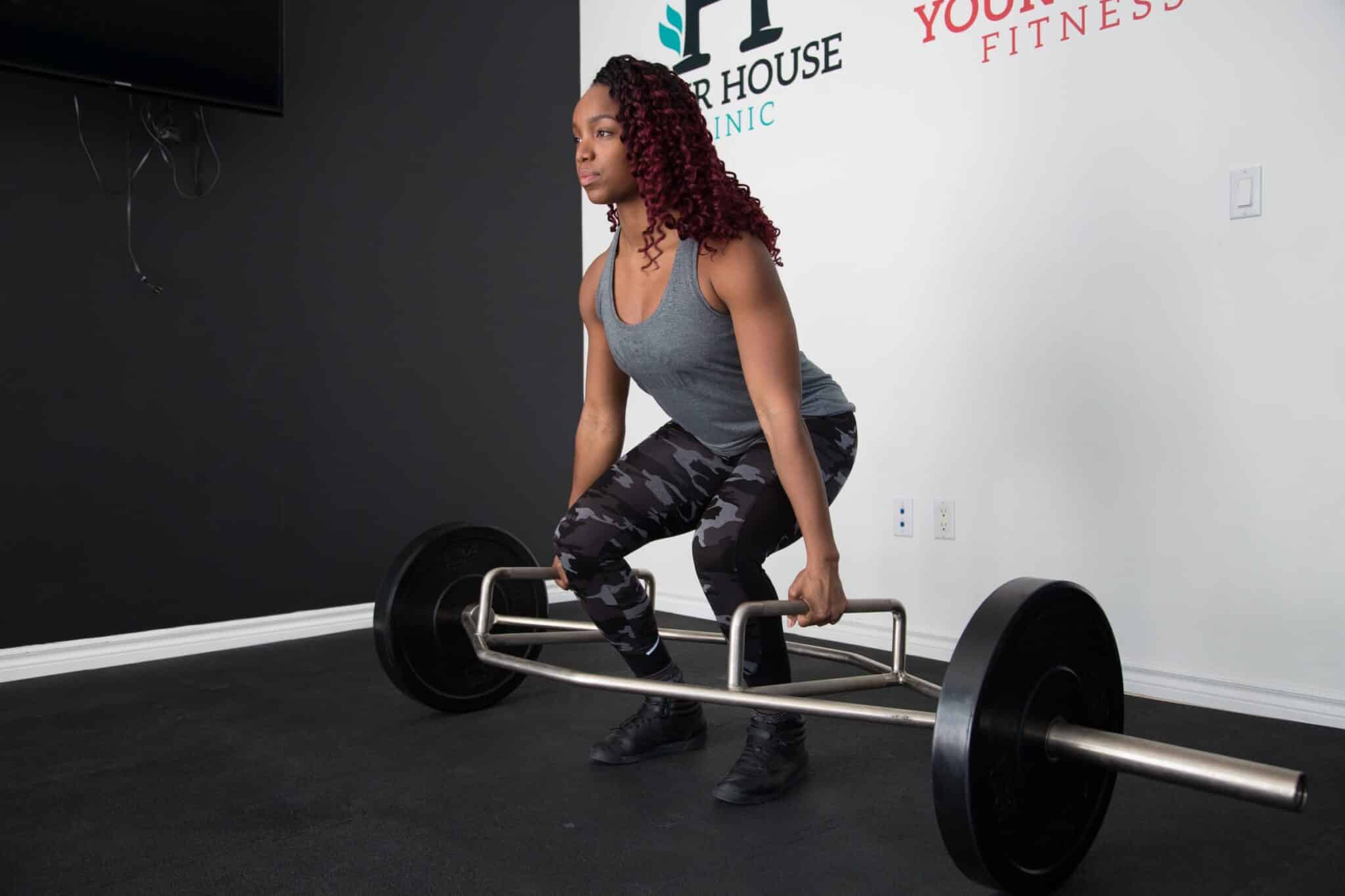
1. It’s More Joint/Back Friendly
Because execution of the exercise requires standing inside the bar – rather than the bar in front of the body – the axis of rotation (hips) is closer to the line of pull reducing much of the shear load on the spine.
The Trap Bar Deadlift allows you to train your hamstrings, glutes, and back muscles without the lower-back strain of traditional deadlifts.
2. It Takes into Account Mobility/Movement Restrictions
Those who lack the appropriate ankle dorsiflexion, hip flexion, and/or t-spine extension to get into proper (safe?) position to begin with will benefit greatly from the trap bar deadlift.
Likewise, from an anthropometric (individual differences in body types and levers) standpoint, the trap bar deadlift will lend itself more advantageous to those with longer torsos, longer femurs, and/or T-rex arms.
Basically, for taller individuals, in addition to those “stuck” in computer guy posture, the trap bar deadlift is a solid, almost long-term, fit.
In English: It allows people to maintain more of an upright posture.
3. It Increases Pulling Strength
The trap bar deadlift is a great exercise to develop foundational pulling strength and muscle mass necessary to deadlift (and even squat) heavier loads.
4. Supramaximal Loading
More advanced athletes/lifters can use the trap bar deadlift to overload the central nervous system and/or allow an athlete to gain experience and confidence attacking and handling heavier loads (than they normally could lift with a conventional/sumo deadlift). This can be helpful to peak maximal strength levels in more developed lifters as well as can help to overload the nervous system in response to near-maximal loads being lifted in greater volumes.
How to Trap Bar Deadlift
Start by assuming a hip width stance with the toes pointed forward (in line with the knees).
Squeeze the bar as you pull the shoulderblades down the back, allowing the chest and shoulders to get pulled upwards.
Push downwards into the floor with the legs, and keep the chest up. Focus on feeling the knees and hips extending as you drive your feet into the ground.
Assume a vertical position with the pelvis neutral (no lumbar extension/flexion) and the upper back set. The shoulderblades should be down the back, with the load being diserpse between the upper back, traps, glutes legs and grip.
Trap Bar Deadlift Form
The stance width will vary, however generally speaking, the width should allow for the athlete to have the shins perpendicular to the floor with the back flat and shoulders directly above the bar.
Without lifting the bar, find full pressure in the foot as you start to load the pull.
Flex the triceps and pull the back taunt.
Squeeze the glutes at the top.
Trap Bar Deadlift Muscles Worked
Most people consider the trap-bar deadlift a “back exercise,” but it trains far more than just your back.
In fact, it trains almost every major muscle group in your body, including your legs, arms, and glutes.
Specifically, it helps develop your . . .
- Latissimus dorsi
- Trapezius
- Erector spinae
- Glutes
- Hip flexors
- Calves
- Quadriceps
- Forearms
Thus, the trap-bar deadlift is really a full-body exercise that trains more or less every muscle in your posterior chain (the muscles on the backside of the body).
The trap bar deadlift works the hamstrings, however to a slightly lower degree than a Romanian Deadlift and/or the conventional deadlift variations.
Due to the increased knee flexion (increase quadricep involvement…see below) the hamstrings are not stressed as much, however are still a primary muscle group.
Due to the hip flexion, the glutes are loaded at high amounts (like most deadlifts) and can be used to increase glute strength, hypertrophy, and functioning.
Nearly all deadlifts target the erectors (lower back muscles), however the trap bar deadlift does decrease the amount of loading placed on the erectors due to the increased back angle (more upright torso, due to greater knee flexion).
This can be helpful for lifters who may have lower back concerns or are looking to not overstress the erectors yet still get in enough pulling volume for muscle growth and strength development.
Trap Bar Deadlift Alternative
Some of the best alternatives to the trap bar deadlift are squat variations, such as front squats, goblet squats, and safety bar squats. This is because the trap bar deadlift places greater emphasis on the quads versus the posterior chain (glutes, hamstrings, low back).
The following 10 exercises are effective Trap Bar Deadlift alternatives:
- Farmer Carry
- Pendlay Row
- Bulgarian Split Squat
- Standing Cable Pull Through
- 45 Degree Back Extension
- Single Leg Dumbbell Deadlift
- Pause Deadlift
- Deficit Deadlift
- Romanian Deadlift
- Block Deadlift
History of the Trap Bar Deadlift
The trap-bar deadlift was birthed in the mid-1980s by a powerlifter named Al Gerard.
Gerard discovered his talent at a young age hoisting sacks of fertilizer in a factory where he worked, and then his passion pulling and pushing barbells in his thirties. By his forties, he was pulling over 600 pounds, but he had also developed a nagging lower-back injury that made any further progress unlikely.
He tried to “train around” his injury by doing dumbbell squats and lunges, rack pulls, and other exercises, but wanted a back-friendly option that more closely mimicked the deadlift.
And after some fiddling, Gerard came up with what he called the “Gerard Device.” The Trap Bar Deadlift was born.
Trap Bar Deadlift Workouts
WORKOUT 1
21-15-9-9-15-21 Reps
For Time:
- Deadlifts (225/155 lb)
- Burpees
With a running clock, as fast as possible perform 21 Deadlifts & 21 Burpees, 15 Deadlifts & 15 Burpees, 9 Deadlifts & 9 Burpees, 9 Deadlifts & 9 Burpees, 15 Deadlifts & 15 Burpees, 21 Deadlifts & 21 Burpees.
Score is the time on the clock when the final Burpee is completed.
Tips and Strategy
The athlete should establish a rep scheme that’s manageable for their current fitness level—and fight hard to stick with it. Rest breaks should be brief. Move smoothly and steadily. Here’s a rep scheme to try:
- 21 Deadlifts: 12-9
- 21 Burpees: Unbroken/Steady pace
- 15 Deadlifts: 10-5
- 15 Burpees: Unbroken/Steady pace
- 9 Deadlifts: 9 (Unbroken)
- 9 Burpees: Unbroken/Steady pace
- 9 Deadlifts: 5-4
- 9 Burpees: Unbroken/Steady pace
- 15 Deadlifts: 5-5-5
- 15 Burpees: Unbroken/Steady pace
- 21 Deadlifts: 7-7-7
- 21 Burpees: Unbroken/Steady pace
In the example above, the athlete does bigger sets at the beginning, and smaller sets towards the end. The goal, regardless of the partitioning, is to keep rest to a minimum.
Intended Stimulus
The workout should feel both mentally (ascending ladders are a mental hurdle) and physically (90 Burpees and 90 Deadlifts!) exhausting. The load for the Deadlifts should feel moderate—not too heavy, not too light. The pace should be strong, and rest should be minimal. A great goal for this workout is sub 20 minutes.
Scaling Options
Scale the load and/or the volume of the workout to prioritize a strong pace and minimal rest. If the athlete has to break the deadlifts up into more than 4 sets, they should reduce the weight. If the athlete thinks that the WOD will take longer than 30 minutes, they should scale the volume (fewer repetitions).
Beginner
12-9-6-6-9-12 Reps
For Time:
- Deadlifts (135/95 lb)
- Burpees
WORKOUT 2
7 Rounds for Time
- 11 Deadlifts (bodyweight)
- 100 metre Sprint
WORKOUT 3
For Time
3-9-15-21-15-9-3
- Deadlifts (205/145 lb)
- Box Jumps (24/20 in)
WORKOUT 4
AMRAP in 7 minutes
- Wall Ball Shots (20/14 lb)
- 5 Deadlifts (225/155 lb) at the top of each minute
Workout starts with Wall Ball Shots. Then, at the top of each minute, starting at 1:00, complete 5 Deadlifts, then immediately resume Wall Ball Shots.
Score is the total number of repetitions (of Wall Ball Shots and Deadlifts combined) completed before the 7-minute clock stops.
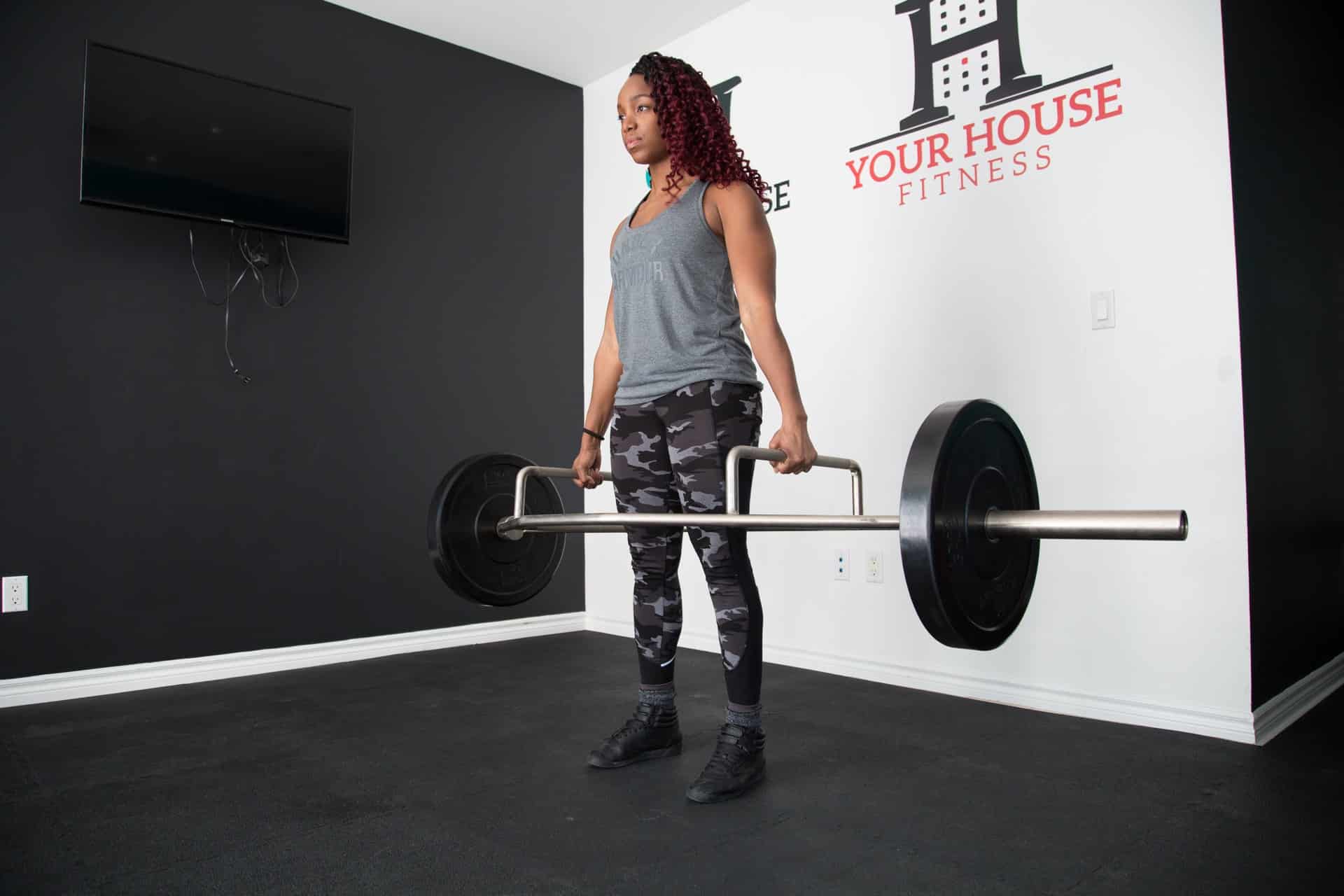
WORKOUT 5
12-9-6-3 Reps for Time
- Deadlifts (60% BW)
- Ring Rows
WORKOUT 6
For Time
10-9-8-7-6-5-4-3-2-1 reps of:
- Deadlifts (315/225 lb)
1-2-3-4-5-6-7-8-9-10 reps of:
- Burpees
Decrease the deadlifts by 1 rep every round and increase the burpees by 1 rep until you do 1 deadlift and 10 burpees.
WORKOUT 7
EMOM for 14 minutes
Odd Minutes:
- 15 Kettlebell Swings (24/16 kg)
Even Minutes:
- 10 Deadlifts (275/205 lb)
WORKOUT 8
For Time
10-9-8-7-6-5-4-3-2-1 reps of:
- Strict Toes-to-Bars
- Romanian Deadlifts (135/115 lb)
Romanian Deadlift starts at the top and lowers until the hamstrings receive tension and stretch.
Scaling
For Time
10-9-8-7-6-5-4-3-2-1 reps of:
- Hanging Knee Raises
- Romanian Deadlifts (95/75 lb)
WORKOUT 9
For Time:
Accumulate 6 Minutes of a Sandbag Hold (150/100#)
*For any break during the Sandbag Hold a penalty of 5 Deadlifts at 1.5xBW will need to be completed immediately following the 6 minutes.
Score: The time it takes to complete the work.
Equipment: For this workout, you need to have all of the equipment set up before you start.
Get your Trap Deadlift bar set to the prescribed weight.
When holding the sandbag you must be standing in place and holding the bag in front of the body and above the waist.
No shoulder or knee loading. Have something to mark with for every drop. After you accumulate the 6-minute hold go to your Deadlift bar and complete the penalty reps.
Scaling
The weight can be adjusted down on the bag or use two kettlebells held in a front rack position. The Deadlift weight can be adjusted to bodyweight.
WORKOUT 10
5 Rounds for Time
- 10 Unbroken Deadlifts (225/155 lb)
- 50 foot Single-Arm Dumbbell Overhead Walking Lunges (50/35 lb)
With a running clock, as fast as possible perform the prescribed work in the order written for 5 rounds. Athlete must complete the 10 Deadlifts unbroken.
If the athlete rests or let’s go of the bar during the 10 reps, the round will not count. Rest or switch arms as needed during the Overhead Walking Lunges.
Score is the time on the clock when the last round of the Single-Arm Dumbbell Overhead Walking Lunges is completed.
Scaling Options
Intermediate
5 Rounds for Time
- 10 Unbroken Deadlifts (135/95 lb)
- 50 foot Single-Arm Dumbbell Overhead Walking Lunges (20/15 lb)
Beginner
5 Rounds for Time
- 10 Unbroken Deadlifts (75/55 lb)
- 50 foot Walking Lunges (20/15 lb)
WORKOUT 11
With a Running Clock in 20 minutes
5 Rounds of:
- 10 Deadlifts (135/95 lb)
- 10 Bar Facing Burpees
Then, in the remaining time, establish:
- 1 rep max Deadlift
On a 20-minute clock, perform 5 rounds of 10 Deadlifts and 10 Bar Facing Burpees. In the remaining time of the 20-minute clock, establish a 1 rep max Deadlift.
There will be 2 scores for this event. Score A is the time to complete the 5 rounds. Score B is the heaviest load successfully lifted for the Deadlift.
WORKOUT 12
For Time
- 20 Deadlifts (185/125 lb)
- 20 Toes-to-Bars
- 20 Deadlifts (225/155 lb)
- 20 Toes-to-Bars
- 20 Deadlifts (275/185 lb)
- 20 Toes-to-Bars
- 20 Deadlifts (315/205 lb)
- 20 Toes-to-Bars
With a running clock, as fast as possible complete the prescribed work in the order written.
Score is the time on the clock when the last round of the Toes-to-Bars is completed.
WORKOUT 13
Three 3-minute AMRAPs in 11 minutes
- 12 Dumbbell Deadlifts (2×50/35 lb)
- 8 Push-Up + Renegade Rows (2×50/35 lb)
Rest 1 minute between AMRAPs
On an 11-minute clock, complete as many repetitions as possible (AMRAP) of the prescribed work in the 3-minute window for 3 rounds. Each round is a 3-minute AMRAP of 12 Dumbbell Deadlifts 8 Push-Up + Renegade Rows.
Rest 1 minute between rounds.
Score is the total number of repetitions completed before the 11-minute clock stops.
Movement Standards
Push-Up + Renegade Row: Athlete will hold one Dumbbell on each hand and perform a standard Push-Up.
Then, pull the right Dumbbell towards the chest and back to the ground. Do the same with the left Dumbbell. This counts as one rep.
WORKOUT 14: Trap Bar Linda
10-9-8-7-6-5-4-3-2-1 Reps
For Time:
- Deadlift (1½ bodyweight)
- Bench Press (bodyweight)
- Clean (¾ bodyweight)
Use three separate barbells. Perform the movements in the order listed and follow the “descending ladder” rep scheme—10 deadlifts, 10 bench presses, 10 cleans, 9 deadlifts, 9 bench presses, 9 cleans, 8 deadlifts, 8 bench presses, 8 cleans, etc. until the last round of 1 deadlift, 1 bench press, 1 clean is completed.
Score is the total time it takes to complete all the repetitions.
Good Times for “Linda”
– Beginner: 28-32 minutes
– Intermediate: 19-25 minutes
– Advanced: 14-17 minutes
– Elite: <13 minutes
WORKOUT 15
3 Rounds for Time:
- 550 metre Row
- 12 Deadlifts (225/155 lb)
- 21 Rings Dips
Tips and Strategy
The biggest challenge of this workout is the bench press. Have a spotter at the bench so you can go hard without fear of being trapped by the barbell mid-rep.
Intended Stimulus
The load in this workout should feel moderately heavy–but not maximal. Scale the load/volume so you can finish this WOD in approximately 30 minutes or less. Avoid scaling to the degree in which “Linda” becomes “The Three Bars of Fun” rather than “The Three Bars of Death.”
Scaling
This benchmark workout contains a high volume of moderate-load weightlifting. Reduce the loads and/or eliminate some of the early rounds to decrease the total volume.
Intermediate Option
10-9-8-7-6-5-4-3-2-1 Reps
For Time:
- 1¼-bodyweight Deadlift
- ¾-bodyweight Bench Press
- ½-bodyweight Clean
Beginner Option
8-7-6-5-4-3-2-1 Reps
For Time:
- ¾-bodyweight Deadlift
- ½-bodyweight Bench Press
- ⅓-bodyweight Clean
Trap Bar Deadlift vs Conventional Deadlift
The discussion of which lift is better is nuanced. One should consider individual preference, training goals, sport demands, and injury history. It is my hope that by explaining the differences between these lifts can help you to determine which one is better on a case-by-case basis.
The trap bar tends to settle into a person’s centre of mass better, requires less teaching, allows for more movement freedom, elicits greater peak power production, reduces the likelihood of low back strain, and places more demand on the thighs.
This does not make it better or worse, just simply different. Content is key!
If someone has knee pain, or a knee injury, a barbell deadlift or even RDL might be a great way to create a training effect without stressing the knees. Whereas if someone has a low back issue, the opposite might be true.
If someone is recovering from a hamstring injury and needs to spend more time strengthening their posterior chain, then a barbell deadlift might be a better option for them.
The barbell deadlift is more challenging on the hips, glutes, and hamstrings than the trap bar. This can be a major advantage of the barbell in some scenarios.
If someone wants to train for powerlifting or weightlifting, it should be pretty obvious that training the lifts they are going to compete in should be their top priority, hence the reasoning behind spending less time with a trap bar and more time with a barbell.
That being said, transfer can still be realized as long as intensity is sufficient and the primary lifts are trained enough to concurrently improve skill.
Trap Bar Deadlift Weight
A typical Trap Bar weights around 60lb/27kg but this will vary depending on the brand.
Is the Trap Bar Deadlift Good for Back?
Similar to most deadlifts, the trap bar deadlift can build serious strength and muscle mass to the trapezius and back muscles.
Due to the increased back angle (torso in a more upright position), lifters may find a greater emphasis on middle and upper back development and less strain on the lower back muscles.
How Can You Strengthen Your Lower Back Without Deadlifts?
You can strengthen the low back without deadlifts by doing exercises such as weighted back extensions, standing cable pull-throughs, good mornings, Pendlay rows, and squats.
One of the best exercises for the lower back is the Romanian deadlift.
What is a Good Weight to Trap Bar Deadlift?
For a trap-bar deadlift, men should lift 1.5x their body weight for five reps. Women should lift their body weight for five reps. For example, a 190-lb. man should be able to dead lift 285 lbs.
Is the Trap Bar Deadlift Cheating?
NO. The Trap Bar Deadlift is not cheating. Just listen to Tony Gentilcore’s 2 cents on the matter.
“Correct me if I’m wrong: but the weight still starts from the floor, right? Someone still has to hinge from the hips with a neutral back position, lift the weight up, lockout, and reverse the action back down, right?
How is this not a deadlift? How is this “cheating?”
What is the Best Trap Bar Deadlift to Buy?
In our experience the Best Trap Bar Deadlift is the Rogue TB-2 Trap Bar.
With the TB-2, Rogue have completely overhauled the original Rogue Trap Bar with a more versatile dual-handle design, SCH 80 pipe Olympic sleeves, and a 25% reduction in weight.
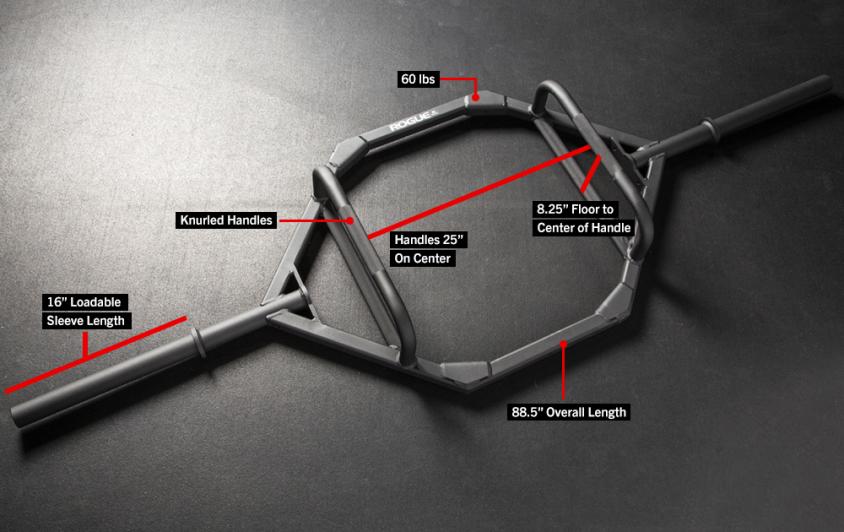
The TB-2 Trap Bar is manufactured in the USA with US steel and features a durable hexagonal frame welded from 1.5” square steel tubing.
Both sets of knurled, parallel handles measure 1.34” in diameter and are spaced 25” on centre.
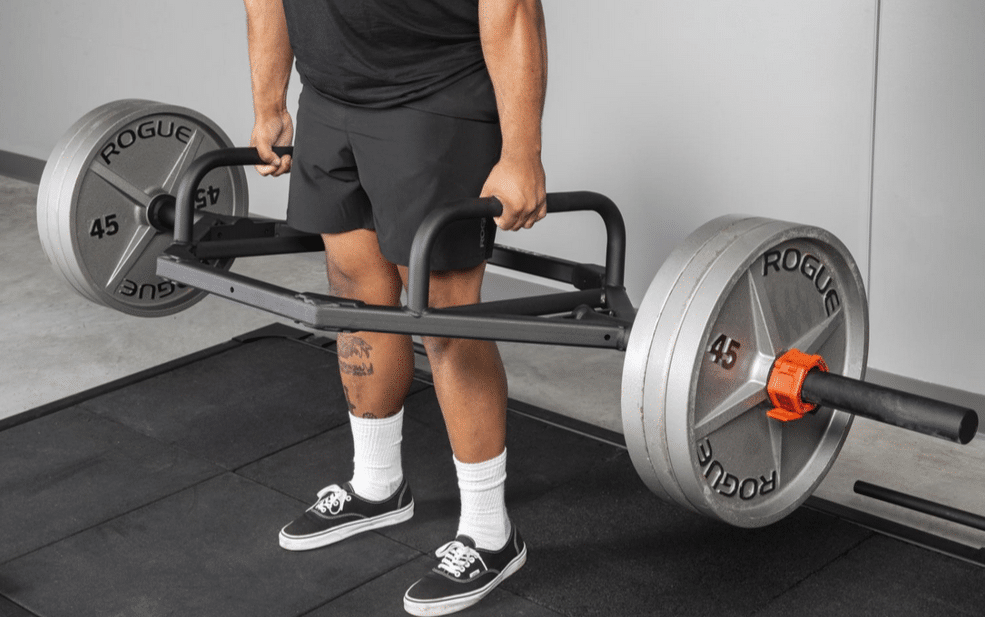
During a workout, an athlete can easily switch from one set of handles to the other simply by flipping the bar over.
This makes the TB-2 advantageous for strengthening the lockout, overloading on shrugs, and/or limiting shoulder stress during bench presses.
It also enables beginners or rehabbing athletes to focus on their range of motion or gradually develop a deadlift program without putting as much pressure on the lower back.
Specifications:
Made in the USA
- Two Sets of Knurled Handles: 1.34” diameter, spaced 25” on center
- Schedule 80 Pipe Sleeves: 1.91” diameter (Oly compatible), 16” loadable length
- Rogue Signature Black Powder Coat
- Patented Design

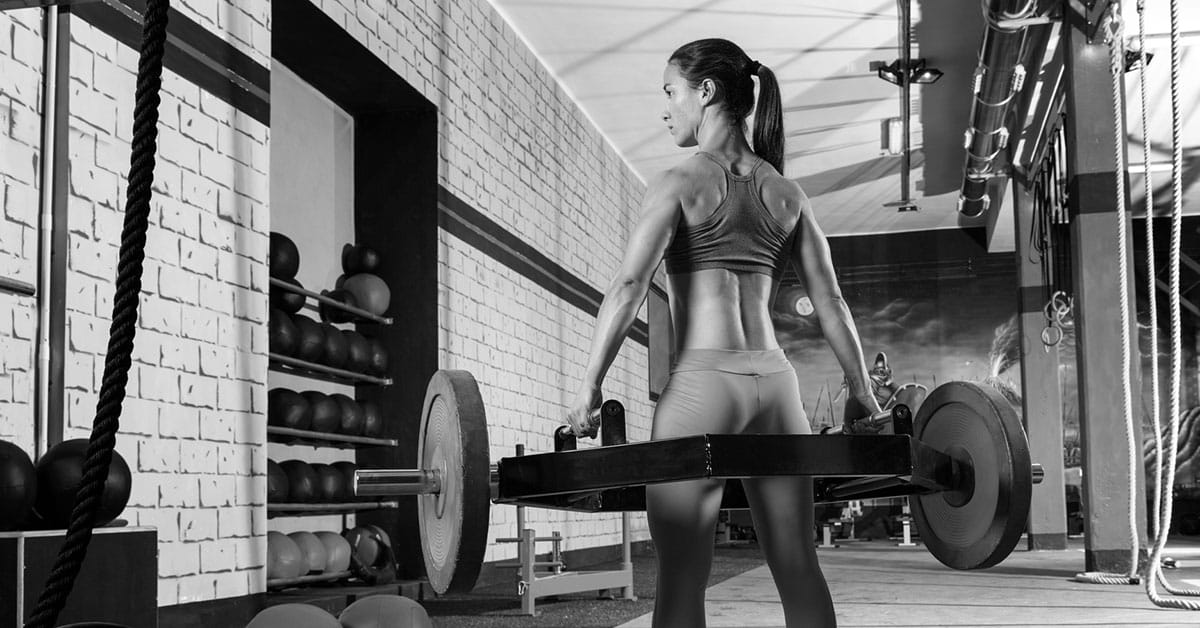



Comments are closed.